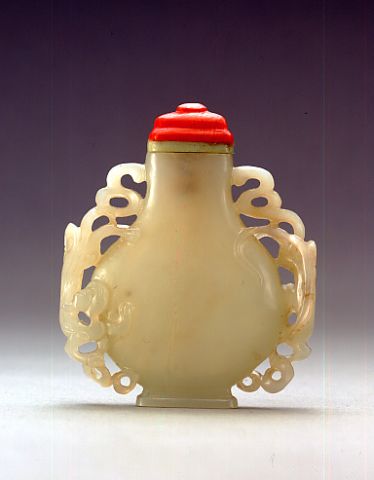
Bottle ID: 516
MOON FLASK WITH DRAGONS
Date: 1740-1795
Height: 47 mm
Nephrite, white, very well hollowed, and of flattened rounded form, in imitation of a larger “moon flask”, the bottle tapering to a rectangular foot and mouth, reticulated and carved in high relief on the shoulders with two dragons coiling playfully down the bottle; their heads and tails carved in low relief on the “moon flask”.
Imperial, attributed to the Palace Workshops, Beijing.
Similar Examples:
Crane Collection nos. 149, 229, 320 and 455
Stevens, Bob C. The Collector's Book of Snuff Bottles, 1976, p. 116, no. 388.
Moss, Hugh, Victor Graham and Ka Bo Tsang. The Art of the Chinese Snuff Bottle - The J & J Collection, 1993, Vol. I, pp. 96-97, no. 39.
Sotheby's, London, April 24, 1989, lot 99, Collection of Eric Young, part III.
Provenance:
Asian Art Studio
Edwin Palmer
Clare Lawrence Ltd.
Richard Starrett
Parallel to this fertile period of Imperial influence, the larger cities of China were still in the throes of economic prosperity, and it was fashionable for merchant and farmer alike to acquire culture in the form of works of art, including jade objects. Of course the increase in demand by different classes of society created variable levels of quality, leading to an overall deterioration in workmanship and what the Emperor Qianlong termed a 'vulgarization' of style. In 1780 he wrote a poem eulogizing the dragon-tailed guang (vase) made from the jade of Khotan (in Turkestan), where in the eleventh passage he states: "Today vulgarization becomes more popular; the ancient styles should be adopted with meticulous care'.
The Emperor, a connoisseur of archaic art, and its pure simple forms, could not appreciate what he termed 'superficial luxury'. What upset him most was the decline in quality that accompanied the commercial upsurge and it was through his determination to combat this that by 1785 the carvers of Zhuanzhu Lane bent to the pressures of Imperial influence. Thus not only did Palace-bound pieces improve but also those destined for the private patron of the arts
< Back to full list
 English
English 中文
中文